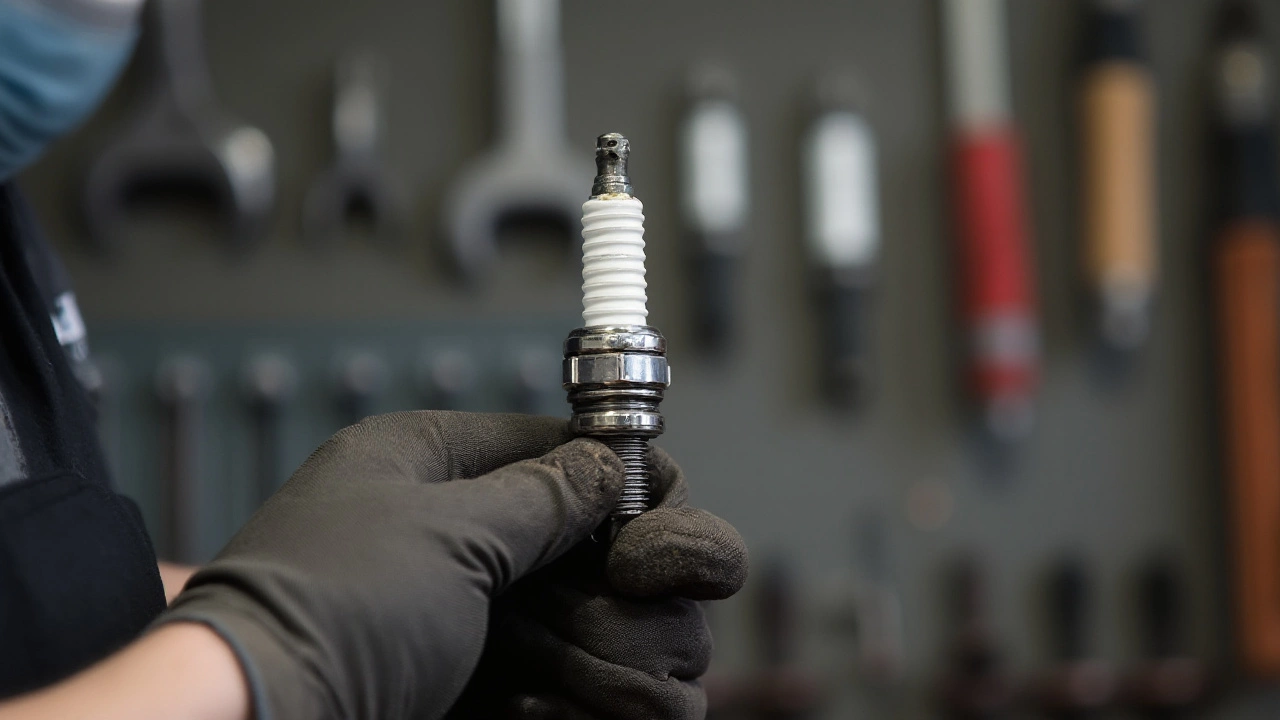Car enthusiasts and owners alike often face a common question during routine maintenance: Is it okay to change spark plugs without touching the wires? Navigating the interconnected relationship between these two components can be a bit tricky if you're not familiar with car mechanics.
Spark plugs are essential for kicking life into your engine by igniting the air-fuel mixture, hence playing a pivotal role in keeping your car purring. But what about the wires? These seemingly simple parts are crucial for delivering the electrical current to the spark plugs. They’re like the unsung heroes behind your roaring engine.
So, does this mean you should replace them at the same time you change your spark plugs? Let’s dive into the intricacies of this automotive dilemma, exploring what you need to know for a smoother, more efficient ride.
- Understanding Spark Plugs and Their Role
- Why Spark Plug Wires Matter
- Indicators for Replacing Spark Plugs
- Signs Your Spark Plug Wires Need Attention
- Benefits of Changing Wires with Plugs
- Tips for Maintaining Spark Plugs and Wires
Understanding Spark Plugs and Their Role
Spark plugs are often described as the heart of the engine, initiating the combustion process that powers your vehicle. These small components, seated snugly in the engine's cylinder head, perform a critical task. They create the electrical spark necessary to ignite the fuel-air mixture within the combustion chamber, kicking off the power cycle that ultimately propels your car forward. Without the spark plug's timely ignition, the engine can't generate the energy needed to run efficiently. The ignition process involves a fascinating dance of chemistry and electricity, where even the minutest of malfunctions can lead to suboptimal engine performance. A worn-out or malfunctioning spark plug can cause misfiring, inefficient fuel consumption, and diminished power output. This makes replacing worn plugs crucial in maintaining a vehicle's performance.
Renowned for their durability, spark plugs are made from materials like iridium or platinum, which offer exceptional heat resistance. These materials ensure that the plugs can withstand the high temperatures and pressures found in the engine's combustion chamber. The lifespan of a spark plug can vary significantly based on the material; for instance, copper spark plugs might last up to 20,000 miles, while those with iridium tips can function efficiently for as long as 100,000 miles. A spark plug's ability to withstand such harsh conditions while maintaining a precise and consistent spark is a marvel of engineering. However, faulty spark plugs can lead to increased tailpipe emissions, something that is not always talked about but can have serious implications for environmental standards.
Modern engines come equipped with a variety of sensors and control mechanisms to ensure optimal performance, but these all rely on the spark plug functioning as intended. When the spark plug fails, issues like engine knocking can emerge, leading to further engine damage if not addressed promptly. Regular inspections can preempt these issues, and checking the condition of your spark plugs can provide insight into the engine's health. A healthy spark plug will have a light tan color, indicating that the engine is running efficiently. If you notice buildup or discoloration, it could be a sign of other underlying issues, such as valve leaks or a clogged air filter.
According to automotive expert Mark Stevens, "The spark plug plays a more important role than most vehicle owners realize. The plug serves as a window into the engine's performance, offering clues about how well the engine is running and pinpointing potential problems before they escalate." Understanding this intricate orchestra of electrical and chemical reactions highlights why spark plugs are indispensable in the realm of modern automotive technology.
Why Spark Plug Wires Matter
Let's take a moment to appreciate the importance of those often overlooked components: the spark plug wires. They might not have the spotlight like the plugs themselves, but they are the backstage crew ensuring the show goes on. These cables are designed to transmit the electrical pulse from the ignition system to the spark plugs consistently. This steady power supply is what makes sure your engine runs smoothly without a glitch. Think of them as the vital lines along which energy flows, crucial to the finesse of engine operation and performance.
While spark plugs ignite the engine, it's the wires that ensure the spark reaches its destination without any loss. Just as a lifeline is vital in critical situations, spark plug wires are essential for maintaining engine performance. Poor or damaged wires can lead to weak spark, misfires, and even engine stalls. They play a pivotal role in maintaining the fuel efficiency and power of your vehicle, not to mention impacting emissions. It might interest you to know that even a slight imperfection in these wires can have a ripple effect, reducing engine life over time.
According to Car and Driver, "Keeping an eye on your spark plug wires is like insurance for your engine's performance."These wires are usually made from materials like silicone, which withstands the high temperatures of engine environments. However, over time, heat, oils, or even general wear and tear can degrade them. Signs include noticeable engine noise, reduced performance, or even strange smells. If these signs arise, it's typically a message that these wires need checking. Adopting a proactive approach can save you from costly repairs or lower gas mileage issues down the road.
It’s worth pointing out that maintaining healthy spark plug wires isn’t just about replacing them when faulty but also involves a bit of preventive care. Simple actions, like checking wires for cracks or ensuring they're securely attached, can go a long way. Engaging in routine inspections to ensure their condition can prevent not just engine troubles but also ensure that each component of your vehicle as a whole functions optimally. Just like a chain isn't stronger than its weakest link, the engine's performance hinges on the state of these wires.

Indicators for Replacing Spark Plugs
In the vast world of automotive maintenance, knowing when to replace spark plugs can make the difference between a smooth ride and a stuttering, fuel-guzzling journey. Your engine's heartbeat is closely tied to these small yet mighty components, and understanding the signs of wear and tear is crucial. You might think that unless the engine light flickers on, there's nothing to worry about, but seasoned drivers know better. One of the first things to notice is a decreased fuel efficiency. If you're visiting the pump more often than usual, spark plugs might be the culprits. This is especially true if your car's mileage has crossed the 30,000 mark, as spark plugs have usually seen better days beyond that.
Another telling sign is trouble starting your vehicle. While a weak battery or faulty ignition system might be to blame, worn-out spark plugs are often the source of the problem. Imagine being late for work and turning the key in the ignition only to hear unsettling noises instead of engine purrs; that jarring experience is often rooted in spark plug issues. Performance issues like power loss during acceleration deserve attention too. Your car should respond eagerly when the accelerator is pressed, not sound like it's straining.
According to an expert from AutoZone, "Regular maintenance of spark plugs can improve your car's speed, fuel economy, and emissions."
Serious indicators that it's time to replace your spark plugs come in the form of engine misfires or popping sounds. These occur when the spark plugs fail to ignite the fuel mixture in the engine cylinders, causing an erratic idle. If left unchecked, a series of minor misfires can lead to significant engine issues down the road. Listening to your car's soundscape and engine hesitations becomes a valuable skill here. And once you've checked these auditory signals, remember to also look out for physical signs. If you decide to visually inspect the spark plugs yourself, pay attention to any visible signs of wear such as burnt or corroded electrodes. A common issue is carbon-fouling, where carbon deposits build upon the electrodes, preventing effective sparking. Cleaning them can sometimes help, but replacing them is often more effective.
Some advanced spark plug models last longer than traditional ones, but every plug has a lifespan. Keeping track of your car's manual recommendations can save you time, money, and stress. A rule of thumb many auto enthusiasts swear by is to check them every two years or 20,000 miles, whichever comes first. This process of regularly assessing spark plug health can seem like an unglamorous chore, but it pays off in spades, ensuring your engine runs smoothly for a long time.
Signs Your Spark Plug Wires Need Attention
When considering your vehicle's maintenance routine, recognizing when your spark plug wires are in need of attention is crucial. These wires may seem like mere conduits within the complex machine that is your car, yet they play a role so vital that neglect could lead to serious engine performance issues. So, how does one ascertain when these wires are crying out for help? The signs are often subtle but telling.
One of the first indicators is a noticeable drop in fuel efficiency. If you're suddenly visiting the pump more often without a change in driving habits, it could signal an issue with the wires. As these connect the spark plugs to the ignition coils, any deterioration could lead to a weak spark. This weak spark makes combustion less efficient, burning more fuel than necessary, and it's a silent hit to your wallet.
Another sign to watch for is engine misfiring. Have you noticed your engine having brief hiccups or perhaps lacking its typical purring smoothness? This can often be attributed to worn-out spark plug wires. Without the consistent flow of electricity to the spark plugs, their timing can be disrupted, causing the engine to misfire. This not only impacts performance but can put undue stress on your engine components.
If your car hesitates when you accelerate or if you notice that dreaded check engine light, consider the possibility that the spark plug wires could be at fault. "Sometimes the most overlooked parts are the ones causing the most trouble," says automotive expert Jane Levere in her handbook on engine diagnostics.
Visual inspection of the wires can offer insights, too. Over time, these wires endure extreme temperatures and vibrations. Look for signs of wear such as cracks, burns, or brittleness in the wire's exterior. Such physical degradation compromises their insulation capabilities and can lead to erratic engine behavior.
In more severe cases, you might experience sparking or arcing. At night, pop the hood and observe; if you spot any tiny sparks jumping around, it’s a clear red flag. This spectacle is more than just an oddity—it indicates the electricity is finding the shortest path possible, bypassing the spark plug and leading to inefficiencies in the engine’s operation. This condition not only affects power output but can also eventually harm the ignition coils.
Listening to your engine is another practical approach to detecting wire issues. If you notice unusual sounds emanating from under the hood, like tapping or rattling, it might be an indication of electrical disruption. Your engine is essentially a large orchestra, and the spark plug wires are strings in the symphony. When they falter, the melody is interrupted.
Addressing spark plug wire issues before they snowball into major repair bills is wise. Not only does it keep your car running smoothly, but ensuring the health of both your spark plugs and wires maximizes the performance and longevity of your vehicle. Remember, attention to these details now can save you from having to replace more significant parts such as the ignition coil or catalytic converter down the line. Keep your car well-tuned and it will reward you with reliability and efficiency on the road.

Benefits of Changing Wires with Plugs
When it comes to car maintenance, replacing your spark plugs paired with new wires might seem like a daunting task at first. But there are compelling reasons why this practice can be highly beneficial, not just for the longevity of your vehicle, but also for its performance and efficiency. One of the most immediate advantages is the improvement in your engine performance. New spark plugs ensure clean and efficient combustion, while fresh wires guarantee a robust and consistent flow of electricity from the ignition coil to the plugs. This synergy helps your engine fire flawlessly, enhancing power output and fuel efficiency.
Consider the reliability aspect. As spark plug wires age, they can develop cracks or other forms of insulation wear. This degradation can lead to misfires or backfires, due to inefficient current delivery. By changing both the plugs and the wires simultaneously, you mitigate the risk of such issues, ensuring that your engine's ignition system operates at its peak condition. This kind of preventive maintenance can save you from unexpected hiccups down the road, particularly if you depend on your vehicle for daily commutes or long journeys.
"Regularly changing your spark plugs and wires is akin to giving your car a fresh lease on life. It smoothens out the ride and oftentimes can lead to better gas mileage," says Anthony Young, an automotive engineer with over two decades of experience.
Looking at the economic aspect, consider this: while there is an upfront cost to replace both components, over time, the efficiency gains and decreased likelihood of costly repairs can be financially rewarding. A well-maintained ignition system ensures that your engine runs smoother, avoiding the dreaded ripple effect of wear and tear that can spread to other car systems. You might even notice a decrease in fuel consumption, as a properly firing engine optimally uses the fuel it receives, which can lead to significant savings, particularly with current gas prices.
Lastly, there's the element of ride quality. Engine misfires can lead to a rough and noisy ride, which can be irritating and even stressful, especially on long trips. Changing the spark plug wires along with the plugs can smooth out your engine's operation, translating into a quieter, more enjoyable driving experience. It's not just about functionality; it's about providing you with a vehicle that feels reliable and responsive over time. This peace of mind is often overlooked, but it is cherished by those who make these changes part of their regular maintenance routine.
Tips for Maintaining Spark Plugs and Wires
Maintaining your spark plugs and spark plug wires is critical to ensuring your engine runs smoothly and efficiently. This journey begins with understanding the role each part plays and setting up a routine to keep these components in top shape. Before diving into intricate maintenance practices, let’s establish why attention to these parts is so crucial. A well-maintained spark plug can improve fuel efficiency, significantly reducing unnecessary emissions, and contribute to a cleaner environment. At the same time, intact wires ensure that the spark is strong enough to ignite the air-fuel mixture in your engine cylinders, preventing performance issues.
For starters, it’s essential to inspect your spark plugs periodically. Begin by checking for signs of wear or carbon deposits, which can result in poor ignition and reduced performance. Building a habit of regular inspections every 10,000 to 15,000 miles can keep your car running at its best. Similarly, evaluate the condition of the wires for cracks, tears, or brittleness. Damaged wires can lead to misfires or cause the engine to run rough.
Replacing spark plugs is relatively straightforward, but always remember to gap them according to the manufacturer’s recommendations. A poorly gapped spark plug may struggle to ignite the mixture, leading to a series of problems, including engine knock or even damage. When it comes time to replace worn-out wires, ensure they are connected correctly; an improperly seated wire can lead to erratic engine behavior or no start conditions.
Routine Maintenance Tips
- Regularly clean your engine bay to prevent dirt buildup around spark plugs and wires.
- Use a dielectric grease on your spark plug boots to keep moisture out and improve connectivity.
- Check your user manual for the recommended replacement intervals, and stick to them.
- Always use the type and brand of spark plugs and wires specified by your vehicle’s manufacturer.
"A well-maintained engine not only performs better but also lasts longer and consumes less fuel," says David Bauer, an expert in automotive engineering.Following these guidelines ensures that your vehicle remains reliable, saving you from unexpected repair bills and providing peace of mind. Keeping a log of maintenance can be an invaluable tool. Record the date and mileage every time you inspect, clean, or replace parts. This diligence builds a historical record that can be critical in troubleshooting future engine concerns.

